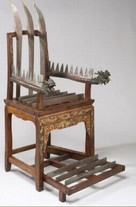 How to set up your workstation - Part 2 About the chair OK, so today, the slightly delayed, second part of how to set up your work-station, this time concerned with your chair. We all occasionally work in silly places; at the breakfast bar perched on a bar stool, with a laptop on the sofa etc but if you are going to be spending many hours a day working, sat in a chair, it is important to get it right, or at least as right as you can. The type of chair you need will be determined by the work you do and also by your desk. What kind of chair do you need If you often turn, perhaps to switch between documents and computer screen, you need a swivel chair. No ifs, no buts, holding yourself in a twisted position for any period of time is a disaster waiting to happen. If you regularly have to get up and down, you probably need a chair on casters, why? Think about the position you put yourself into trying to tuck your chair in, perhaps you do those little bunny-hops? My back muscles are going into spasm just thinking about it. If you’re going to have casters then make sure the floor around your desk is flat and unimpeded, ideally without a thick pile to the carpet. You want to be able to wheel the chair easily. Trying to drag a chair on wheels over an uneven surface can be as hard as doing those bunnyhops! You also want a chair that adjust for height, more about that in a minute. How should you position your chair So you’ve got the right chair, or at least the best you can find in the office, and now you need to know how to position it. There are two major considerations, height and distance (well, and being face on but we covered that earlier). Height is easy, you want your shoulders relaxed and your elbows at 90’ when you’re working. Ideally you want your knees at 90’ also, so if you’re not very tall you may need a footrest to achieve this. Now to one of my pet hates…You have set the chair at the correct height, but you still can’t work with your arms relaxed…Why? Because you can’t get close enough to your keyboard or document…The arms on the chair won’t fit under the desk! I used to work in an office which was very hierarchical. Team leaders’ chairs could be identified because they had arms. ‘Aren’t these slightly too high hard plastic arms comfortable to rest my own forearms on’, said no one ever. Get them removed, if you can, they usually unscrew, even if it looks like a demotion. Kneeler chairs and stability balls Patients often ask me what I think of kneeler chairs and stability balls. There is some evidence that kneeler chairs, set to 20’ allow the lumbar spine to more closely mimic standing posture (Bettany-Saltikov J, 2008). As to whether that is a good thing? Actually there doesn’t appear to be a correlation between lumbar lordosis and back pain (Ashraf A, 2014) (Murrie VL, 2003) and more directly there doesn’t seem to be evidence of a measurable causative effect between low back pain and long periods sitting (Darren M. Roffey, Eugene K. Wai MD, Paul Bishop DC, Brian K. Kwon MD, & Simon Dagenais DC, 2010), which was a surprise to me. That doesn’t mean that for some individuals a standard chair won’t cause back pain and the kneeling hair isn’t going to be more comfortable or irritate pre-existing conditions less. The same goes for balance balls, there is evidence that people with low back pain have deep abdominal muscles that fire less strongly when sitting and that balance balls cause deep abdominal muscles to fire (Rasouli, Arab, Amiri, & Jaberzadeh, 2011), these muscles were thought to be essential for ‘core stability’ and that their poor firing left the back unprotected and unstable; however there is also evidence that those patients who have these muscles damaged or missing for one reason or another, often manage desk jobs without developing low back ache (Lederman, 2008) My advice is to go with what is comfortable, if you can swap throughout the day then maybe that is a good solution, but don’t forget to adjust heights etc to make sure each sitting position is optimal and don’t forget that kneeling chairs don’t swivel, so aren’t great if you are swapping between documents and screen work. Next time, the other bits and bobs at your workstation References Ashraf A, F. S. (2014). Correlation between Radiologic Sign of Lumbar Lordosis and Functional Status in Patients with Chronic Mechanical Low Back Pain. Asian Spine Journal, 565-570. Bettany-Saltikov J, W. J. (2008). Ergonomically designed kneeling chairs are they worth it? : Comparison of sagittal lumbar curvature in two different seating postures. Studies in Health Technology and Informatics, 103-106. Darren M. Roffey, P., Eugene K. Wai MD, M. C., Paul Bishop DC, M. P., Brian K. Kwon MD, P. F., & Simon Dagenais DC, P. (2010). Causal assessment of occupational sitting and low back pain: results of a systematic review. Spine, 252-261. Lederman, E. (2008). The myth of core stability. Journal of bodywork and movement therapies, 84-98. Murrie VL, D. A. (2003). Lumbar lordosis: study of patients with and without low back pain. Clinicical Anatomy, 144-147. Rasouli, O., Arab, A. M., Amiri, M., & Jaberzadeh, S. (2011). Ultrasound measurement of deep abdominal muscle activity in sitting positions with different stability levels in subjects with and without chronic low back pain. Manual Therapy, 388-393.
0 Comments
Your comment will be posted after it is approved.
Leave a Reply. |
Archives
February 2024
AuthorDamian is the principal osteopath at Vauxhall Village Osteopathy and Oval Osteopathy Categories
All
|


 RSS Feed
RSS Feed


